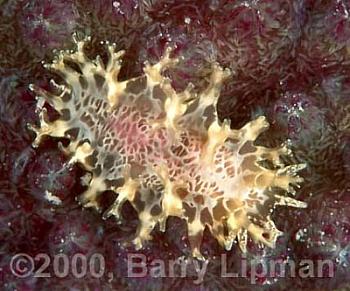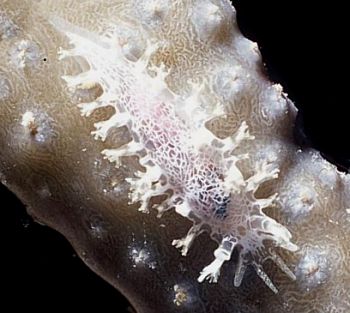
Tritonia bayeri
Marcus & Marcus, 1967
Order: NUDIBRANCHIA
Suborder: DENDRONOTINA
Family: Tritoniidae
DISTRIBUTION
Caribbean Region
PHOTO
Grand Cayman Id, Cayman Islands, Caribbean Sea, September 2000. Approx 50 feet. Approx 1/2 to 3/8 inches (1cm) Photo: Barry Lipman.
Little known of the living animal. Colour and shape briefly described by the Marcus's (1976) as 'living slugs are diaphanous with an opaque white diffuse network on the notum .... The branchiae are white, the velar processes and those of the rhinophoral sheath are peppered with white. The pinkish or dark intestine shines through the notum. There are 4 long tentacular velar processes, and although not described, a median dorsal white line down the posterior foot is visible in the drawings. Preserved animals ranged from 4-5 to 11 mm.
References:
• Marcus, Ev. & Marcus, Er., (1967) Tropical American Opisthobranchs. Studies in Tropical Oceanography, 6: 1-137.
• Marcus, Ev (1983) The Western Atlantic Tritoniidae. Bolm. Zool., Univ. Sao Paulo, 6: 177-214
Rudman, W.B., 2000 (September 25) Tritonia bayeri Marcus & Marcus, 1967. [In] Sea Slug Forum. Australian Museum, Sydney. Available from http://www.seaslugforum.net/find/tritbaye
Related messages
Tritonia bayeri from Florida
October 17, 2001
From: Anne DuPont

Hi Bill,
Can you confirm that this is Tritoniopsis frydis? The photo was taken on August 22, 2001 in 35 feet of water on a night dive, off Pompano Beach, Florida, USA. The critter was about 1/2 inch long and was found on a purple rope sponge. We have done several night dives at this site, and we only find them at night, and only on this type of sponge, and most of them were smaller than this one.
Anne.
akdupont@bellsouth.net
DuPont, A., 2001 (Oct 17) Tritonia bayeri from Florida. [Message in] Sea Slug Forum. Australian Museum, Sydney. Available from http://www.seaslugforum.net/find/5481Dear Anne,
Although it looks superficially like Tritoniopsis frydis there are a few features which make me pretty sure it is Tritonia bayeri. Firstly the translucent clear body with its very obvious reticulate network of opaque white are characteristic of T. bayeri and the relatively small gills are quite different from the position in Tritoniopsis where the gills are usually much more extended and 'bushy'. The most important difference is the shape and number of the papillae on the edge of the oral veil. Tritoniopsis frydis has numerous papillae along the edge, alternating between large and small. In Tritonia bayeri there are only four relatively long and large papillae as can be clearly seen in your photo.
One difference between your photo and Marcus's original description is that they describe a long papillae, similar in size and shape to those on the oral veil, originating from the edge of the rhinophore sheath. I can't see any sign of it in yoru photo or for that matter in Barry Lipman's earlier photo. Perhaps the Marcus's misinterpreted a shadow in the photograph they used to draw the animal. I am not sure, but it a charcter worth checking in other specimens.
Interestingly both species were described from animals found in the Florida region. The animal you have photographed T. bayeri on is not a sponge, but rather a gorgonian octocoral, in which the polyps are retracted. Tritoniids feed on a variety of soft corals and Marcus & Marcus report this species from a soft coral "... Briareum asbestinum (Pallas), feeding after the manner of Cyphoma .. " and a gorgonian "on Pseudopterogorgia".
Thanks for the interesting record, and when you find some, I am still interested in some photos of Tritoniopsis frydis.
Best wishes,
Bill Rudman
Tritonia bayeri from the Caribbean
September 27, 2000
From: Barry Lipman

Hi,
This is the second of two critters I found on a very popular dive site on Grand Cayman last week [September 2000]. The depth was about 50 feet. Both were found at night on the same dive, on coral or on a sponge, where the sand meets the reef. They are very small, 1/2 to 3/8 inch or so.
Best wishes,
Barry Lipman
b_lipman@hotmail.com
Lipman, B., 2000 (Sep 27) Tritonia bayeri from the Caribbean. [Message in] Sea Slug Forum. Australian Museum, Sydney. Available from http://www.seaslugforum.net/find/3079Dear Barry,
This is a soft coral-feeding nudibranch of the family Tritoniidae. I am pretty sure it is Tritonia bayeri but I am relying on the original scientific description of the animal and that unfortunately did not give very much information on the colour of the living animal. If we are lucky, someone with a personal knowledge of the Caribbean fauna will either confirm this identifcation or let me know I am wrong. So if you don't visit the site regularly, keep a watch on the site for a couple of weeks.
If you have further photos of this animal it would be useful to have a clearer view of the head to check the shape of the oral veil, and the 'tail' to check whether there is a white line down the midline. Tritonia bayeri has about 4 long finger-like tentacles around the edge of the oral veil and it has a white median line down the posterior tip of the foot. I think I can see both these characters in your photo but confirmation would be useful.
Best wishes,
Bill Rudman.
